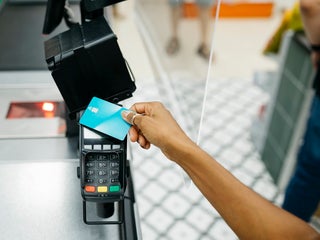Summary
Gen Z and millennials are more likely to skip a tip, and the pandemic hasn’t been a big boon for service providers.
The content on this page is accurate as of the posting date; however, some of our partner offers may have expired. Please review our list of best credit cards, or use our CardMatch™ tool to find cards matched to your needs.
The COVID-19 pandemic fueled demand for some services but hasn’t necessarily led to an ongoing influx of more – or bigger – tips for service workers.
Millennial and Generation Z consumers are less likely to tip everyone from the barista at a corner coffee shop to the Uber driver taking them to the airport, and the pandemic hasn’t increased the percentage of service users who say they always tip, a new CreditCards.com tipping survey found.
Of all the tipping scenarios presented in the June 2021 online survey of 2,573 U.S. adults, sit-down dining is most likely to garner a tip. About 75% of customers who eat in sit-down restaurants say they always tip, and only 5% say they never tip, according to the survey. (See survey methodology)
But when they do tip, customers typically leave standard amounts. Among customers who tip in various situations, the survey found these average tip amounts:
- Dining at a sit-down restaurant: 20%
- Food delivery: 17%
- Picking up takeout food: 15%
The number of food service users who say they always tip fell slightly in the new 2021 tipping survey compared with our pre-pandemic tipping survey. For example, the percentage of sit-down restaurant diners who say they always tip is down two percentage points, from 77% in 2019. And the percentage of food delivery customers who always tip fell four percentage points to 59%, despite skyrocketing demand for food delivery services during the pandemic.
That’s a surprise to CreditCards.com industry analyst Ted Rossman, who expected the pandemic to have a bigger impact on Americans’ tipping habits.
“Delivery people and food industry workers literally risked their lives to do their jobs over the past 16 months,” Rossman said. “It has been an incredibly difficult time to work in the service industry.”
Are millennials and Gen Z stingy tippers?
There are two aspects to being a good tipper: The act of leaving a tip and the amount. Millennials may be less likely than older generations to leave a tip. But when they do, the tip may be slightly higher.
The survey found that the likelihood a customer will leave a tip decreased by generation in all tipping scenarios presented. For example, here are the percentage of service users who say they tip without fail:
- Servers or waitstaff at a sit-down restaurant – 88% of boomers, 80% of Gen Xers, 58% of millennials and 56% of Gen Zers say they always tip.
- Food delivery drivers – 75% of boomers, 65% of Gen Xers, 44% of millennials and 40% of Gen Zers say they always tip.
- Hair stylists and barbers – 76% of boomers, 69% of Gen Xers, 49% of millennials and 35% of Gen Zers say they always tip.
- Taxi and rideshare drivers – 66% of boomers, 48% of Gen Xers, 34% of millennials and 32% of Gen Zers say they always tip.
- Hotel housekeepers – 37% of boomers, 28% of Gen Xers, 20% of millennials and 18% of Gen Zers say they always tip.
The service categories least likely to get an “always tip” response from all generations in the survey: Coffee shop baristas (23% always tip and 24% never do) and restaurant cashiers ringing up takeout meals (17% always tip and 33% never do).
And there’s a silver lining for service providers with many younger customers: When millennials do tip, they tend to be slightly more generous than other generations.
For example, at sit-down restaurants, millennials leave on average a 21% tip compared with the 20% left by boomers, Gen Xers and Gen Zers. They also leave slightly higher tips for food delivery (19%, compared with 18% for Gen Zers and 16% for Gen Xers and boomers) and takeout (18 %, compared with 16% for Gen Zers and 13% for Gen Xers and boomers).
Tipping experts can’t say for sure why there’s a generational paradox that makes millennials and Gen Zers less likely to say they “always tip” but more generous when they do tip.
The failure to “always tip” may be a matter of having lower income. Or, it could be that some people lump in their experiences at buffet-type restaurants where customers may be less likely to tip, says tipping expert William Michael Lynn, professor of consumer behavior and marketing at the Cornell University School of Hotel Administration.
It’s also interesting to note that 82% of Gen Zers got their first work experience in a restaurant, according to the National Restaurant Association Educational Foundation. National etiquette expert Diane Gottsman teaches college students who tell her their service work experience has made them better tippers.
“If you have worked in the hospitality industry, you tend to tip better because you know what it’s like,” Gottsman said.
Tipping strongly linked to income
The survey found a strong correlation between income and tipping habits. For example, 82% of high-income people (annual household income of $80,000 or more) say they always tip at sit-down restaurants compared with 73% of middle-income households ($40,000 to $80,000 a year) and 58% of lower-income households (under $40,000 a year).
This may help to explain why older generations claim to “always tip” more often, Rossman pointed out. “Older adults have more money, generally speaking,” he said.
Did the pandemic increase tipping at all?
It seems many Americans at least had plans to tip more generously due to empathy for the difficulties faced by service workers and small businesses during the COVID-19 pandemic.
The survey found that more than two out of three (67%) U.S. adults want to help businesses and workers who lost money during the pandemic. In fact, 35% say they plan to tip service providers more generously while others say they plan to patronize local businesses more frequently (44%) or pay extra for existing services or pay for unused services (13%).
“While it’s encouraging that many say they will increase their tips, even more people projected that last summer, and our data suggests that didn’t end up happening,” Rossman said.
But Lynn says he looked at two studies that showed an uptick in tipping during the pandemic. One study showed a Texas pizza delivery driver’s tips increased by $1.24 per order over several months during the pandemic. And another study based on data from payment company Square showed an increase in credit card tips for card-not-present transactions at full- and quick-service restaurants. There was a slight decrease in tips for card-present transactions for full-service restaurants, which Lynn attributed to a “dramatic change in the nature of the service” during the pandemic.
“Pre-COVID, card-present transactions were mostly dine-in, and during COVID, card-present is mostly carry out,” Lynn said. “Americans, generally speaking, don’t like tipping for carryout.”
Stiffed? Why customers don’t tip or tip less
Because there are few hard-and-fast rules on tipping, many calculations go into the decision to tip – or not.
In some cases, the customer may just think the service doesn’t warrant a tip. For example, Lynn doesn’t tip a barista who hands him a black coffee. “It’s like getting a coffee from McDonald’s. I just don’t see the service,” he said. But it would be different if the barista whipped up a specialty drink: “If I ordered a latte, I’d tip.”
People who do tip may cut the size of their tip for a number of reasons, the poll found. In fact, 77% say they would reduce their tip while dining in a restaurant under some circumstances. The most common reasons for tipping less than planned at a sit-down restaurant are:
- Unfriendly staff (56%)
- Waiting too long (34%)
- Not getting what they ordered or expected (34%)
“Often people don’t want to tip because the bill was really high or the food didn’t come out on time or wasn’t cooked appropriately,” Gottsman said. “But all of those things are not the server’s fault.”
Tipping tips from etiquette experts
It can be hard to know when and how much to tip. Here are a few tipping dos and don’ts:
- Do: Learn tipping norms. It can be tough to remember when and how much you’re supposed to tip. Look up guidelines for common scenarios (see our tipping chart below for a start) and start tipping accordingly, Lynn recommended.
- Do: Carry cash. If you carry only your debit or credit cards, you’re likely to find yourself in an awkward tipping situation, Gottsman said. “If you’re not carrying cash, you’re not prepared,” she said.
- Do: When in doubt, ask. Not sure if you should tip or if the service provider is allowed to accept a gratuity? It’s an awkward situation that can be alleviated by being open and honest, financial psychologist Brad Klontz said. “You can say, ‘Hey, is it OK if I give you a tip?'” he added.
- Don’t: Stiff for bad service. Keep in mind that tipping is built into the compensation structure for some service workers, Klontz pointed out. “For some people, it’s not bonus money,” he said. “This is part of what they’re relying on to feed their family.”
- Don’t: Buy into a “guilt tip.” Did an electronic message pop up asking if you want to leave a tip while you’re buying a bouquet of flowers or a bottle of wine at a store? No tip is necessary for a cashier ringing up a purchase Gottsman said. “We have to get comfortable hitting the ‘no tip’ button at a cash register,” she added.
And what about the future of tipping on the other side of COVID-19? As restrictions lift and more people dine out and travel, it’s fine to ease back into a more standard pre-pandemic level of tipping, Gottsman said. “You can tip graciously, respectfully and generously, but you don’t have to break your budget,” she advised.
Survey methodology
CreditCards.com commissioned YouGov Plc to conduct the survey. All figures, unless otherwise stated, are from YouGov Plc. Total sample size was 2,573 adults. Fieldwork was undertaken June 16 to 18, 2021. The figures have been weighted and are representative of all U.S. adults (aged 18 and over). The survey was carried out online and meets rigorous quality standards. It employed a nonprobability-based sample using both quotas upfront during collection and a weighting scheme on the back end designed and proven to provide nationally representative results.
Editorial Disclaimer
The editorial content on this page is based solely on the objective assessment of our writers and is not driven by advertising dollars. It has not been provided or commissioned by the credit card issuers. However, we may receive compensation when you click on links to products from our partners.





